Warm Heart of Tanzania
“I want to force the Serengeti to disappear into my eyes”. That was the sentence humming in my mind when making the final preparations for a trip to Tanzania. The feeling had been present since pre-pubescent times, but to hear it sung in such a ravenous way stirred a dormant lust for the clear horizons of Eastern Africa.
Along with the Serengeti, Tanzania held two other worldly mirages: Kilimanjaro and the island of Zanzibar. They would be supreme destinations on their own, but to be able to see them all in one go was an unmissable opportunity.
As with other trips, we would divide our time somewhat evenly between running/climbing/exploring/gawking at natural/cultural wonders and doing nothing by the beach, to harden the bones against the shivering stasis of life in Northern Europe.
And so we arrived in Dar Es Salaam. Not for long though. The Tanzanian capital was nothing but an amorphous blur of heat and a gargantuan rising sun as we sped from the airport to a derelict bus station in search of a ride into Northern Tanzania. Easier said than done. We became embroiled in a mass of dark faces, some smiling/some frowning but all approaching in tall waves and in all likelihood thinking the same surprising thought: what are those two skinny white idiots doing here on their own?
We eventually managed to secure transportation aboard a reasonably sturdy bus, brimming with sweaty bodies busy with rainbow-colored bags and lost feathers. We sat curious yet shy.
Once outside the urban sprawl, the landscape swiftly changed from soiled grey to dry ocher limned by bursts of vivid green. Slowly we made our way to Moshi, where we would try to catch a glimpse of Mt Kilimanjaro. We would not attempt to climb it though. Our time was short and other, more expansive landscapes beckoned. A vision of Kili, as it is affectionately called by the locals, would suffice. We arrived in Moshi late in the afternoon, exhausted bordering on delirious.
The following day would be our only chance of seeing Kili at a reasonable distance, so we had searched the interwebs for an accommodation geographically suited to the occasion. Mount Kilimanjaro View Lodge was eventually booked. Getting there was like stirring a surreal cauldron of hardship. Philip, the lodge’s owner, had advised by email it would be best to arrange transportation through him. Being of the adventurously doltish sort, we embarked on a solo quest to find a taxi driver who knew of the place. We soon stumbled upon one, but later discovered his idea of knowing is more akin to a lack thereof – a common malaise afflicting the taxi driver population. As the African sun made its regular descent, our journey became a comedy of errors.
Lost in the slopes of Kilimanjaro
Setting: the lush slopes of Mt Kilimanjaro, Northern Tanzania.
Main characters: FW, Elle, a lost taxi driver.
Secondary characters: numerous villagers, a sun-dappled infant, another taxi driver, hotel owner.
Plot summary: FW & Elle struggle to keep awake; original taxi driver stops the car halfway through a mountain (fuel is now scarce); neighboring residents start popping up from the jungle; children are brought forth to see the foreigners; a cell phone is procured among the locals; calls are made to hotel owner; another taxi driver arrives at the scene; small talk ensues; FW & Elle depart on taxi#2; taxi driver #2 also does not know where hotel is; a villager tags along to show the way; whole gang is lost in darkness; random villagers provide directions; taxi#2 is unable to climb the mountain further; crew leaves taxi#2 and starts walking upwards; a faint light shines atop encroaching vegetation; FW & Elle arrive at hotel, incredulous; taxi#2 eventually arrives at hotel, East African reggae blaring through its speakers – much merriment ensues.
The End.
***
Following an introduction to our cabin, we scrambled for some food while already dreaming of sheets and pillows. The hotel did not have lighted paths, so we had to tread carefully when descending to our room. Once there, we took a moment to see our surroundings. There was nothing in the horizon. Everywhere was pitch black. We could have been in any mountain in the world. However, as I looked up to the sky I could see whole galaxies, and stars glinting like white pebbles in an endless dark beach. Never had we seen such a glowing firmament. We went to sleep enraptured.
We woke up in a celebratory mood. It was my birthday and my only chance to see Kili. I dashed outside in the early hours of a clear morning, hoping to see the highest mountain in Africa. Standing above an exuberant landscape, I looked to my right – and there it was, high and mighty, dwindling snow streaking its thick slopes.


View to Mt Kilimanjaro
We spent the entire cloudless morning admiring the beauty of Kili. After meeting fellow travelers during breakfast and sharing adventures, we left to Arusha on a rickety bus. Like Moshi, Arusha is small, hot and quaint. Our base would be Toumaini Cottage, on the outskirts of town. Once there, resting under the avocado tree, we felt like long lost pilgrims returning home. Andy, the owner, regaled us with great stories and simple pleasures. His lovely wife cooked excellent meals and made us gallons of masala tea which we gulped with relish. The next morning we would start our greatest adventure yet.
It’s difficult to explain how ridiculously impossible a visit to the Serengeti seemed to us. Such an expedition could only be undertaken by seasoned travelers, hunters of yore, the wealthy, the scientists, David Attenborough or National Geographic crews. How could we dream of ever seeing the sweeping plains of the Serengeti?
And yet, our enormous Land Rover jeep arrived, driven by our guide Masawe. Soon we left for Roy Safaris‘ headquarters in Arusha, where we would go over the details of our 4-day safari. Our mains stops would be: Lake Manyara, Serengeti and Ngorongoro.
***
Day 1 – Lake Manyara
Driving towards Lake Manyara. The asphalt road crisscrosses through scattered huts and faded shacks selling fruit and bottled water. We are enthralled by our immediate future but timid of our situation. We are not used to personal drivers, usually relying solely on public transportation.
The first few hours are awkward, as we are not sure how to address Masawe or how comfortable we should be with a stranger. We arrive at Lake Manyara’s entrance in the early afternoon. We are provided with picnic lunches and settle under a swath of leafy fig trees. Sharing food eases the breaking of the ice, and we are soon on more familiar terms.
Replenished, we begin our journey into the shallow waters of Manyara, huddled in the East African Rift Valley. It is here we begin our introduction to a unique natural world. The colors are red, brown, yellow and shimmering blue, speckled with occasional dark green.
We stop to observe baboons of various sizes and dispositions, grooming or running in the woodlands. Later, we see a lone elephant traversing the shelterless flood plains. His solitude is in stark contrast to the social shenanigans hippos, impalas and wildebeest seem to relish in.
We also get our first sighting of wild zebras and giraffes as we loop around Lake Manyara National Park. Masawe begins to prove himself as a reliable source of information and a keen set of eyes for spotting wildlife. Already suffused with a sense of swelling wonder for the matchless natural exuberance of Northern Tanzania, we leave to dine and sleep at Bougainvillea Safari Lodge.
We need a moment to understand how the whole practical side of things works, as in: where does Masawe eat and sleep? We are told there are other drivers around, and their accommodation and nourishment is included in the safari price. Everybody we meet seems to be much more knowledgeable than us in regards to how a safari works. We are new at this and still suffer pangs of colonialist guilt. Masawe seems happy to see some friends though, so we set a time for tomorrow’s outing (very early) and everybody goes their own way.
Lying awake in bed, I try to accommodate a trip to the Serengeti in my brain’s list of achievements. I am having trouble convincing myself it’s really happening.

Elle in Lake Manyara

The loneliness of the long distance mammoth
***
Day 2 – Ngorongoro and Serengeti
We meet Masawe after a daybreak breakfast and promptly start driving to Serengeti National Park. Our jeep finally leaves the asphalt road when we enter the Ngorongoro Conservation Area, and we begin careening through the bumpy dirt road leading to the Serengeti. We stop briefly to admire Ngorongoro Crater from its rim. We are awestruck by what to this day is the most magnificent natural vision we ever had the luck to experience. Seeing the gigantic, exquisitely drawn caldera from above leaves us intoxicated but also drained. It is a place for which the word breathtaking attains a literal sense.
We continue bouncing through the crater’s rim, into Ngorongoro’s highlands, passing the stone grave of Bernhard and his son Michael Grzimek, German conservationists and filmmakers responsible for the film Serengeti Shall Not Die. We are reminded of both our species’ fickle relationship with Nature and the barren outcome of a flickering life.
Ngorongoro’s highlands are reminiscent of a primordial time. Scattered clouds zoom across towering slopes and iridescent valleys, creating an adagio of light and shadow punctuated by congregated black zebra dots.
On top of the world, suddenly the giraffes are restless. Elands scurry about, jumping gracefully across the road. We try to ascertain the reason for such unexpected commotion. Amidst the greenery, we discern the bright red and blue garments of the Maasai treading in unison, their spears cutting the hot air in synchronous movements.
We begin our descent into the Serengeti plains. Along the way, we pass through Oldupai Gorge, hotbed of early human evolution and landmark of the Great Rift Valley. Our day ticket for the Serengeti meant that the later we went in the later we could come out. We were in no hurry.
With time to spare, Masawe leads us away from the main road and into a jolting wilderness. We stop for lunch, surrounded by zebras, gazelles and untrammeled hordes of wildebeest.
We are now completely comfortable in Masawe’s presence, and he seems relieved by our newfound familiarity.
We finally enter Serengeti National Park, UNESCO World Heritage Site and dream come true. On our way to Nasikia Camp we spot a lioness with her two cubs. Masawe approaches with caution, careful not to spook them. We stay grinning at the homely gathering for a few minutes.
We arrive at Nasikia Camp by late afternoon. Our bones are shred to pieces. However, our newly auburn skin glistens under the setting sun. We meet other travelers, all older than us by at least a decade. The camp is small and consists of an assortment of camouflaged tents equipped with modern comforts. It’s a mobile camp, which means it will move according to the seasonal rush of wildlife. If Tarzan could see us now…
We come to terms with being in the middle of the Serengeti, ready to spend the night. We would prick ourselves if we weren’t so tuckered out. As we leave the open bonfire for bed, we hear Masawe laughing with his companions. Surrounded by saturnine grassland, we also hear a faint rustling, accompanied by low growls. We scamper to our tent and zip it tight. We sleep soundly, knowing feline predators are notoriously clumsy with zippers.

Ngorongoro Crater

Maasai village

Maasai Herdsmen in the Ngorongoro Highlands
***
Day 3 – Sunrise in the Serengeti
We wake up in the Serengeti. (Such a delicious turn of the tongue…)
We rush outside in time to see the glorious African sun rising in the horizon. All day we meander, going hours without seeing another jeep. It takes us a minute or so to recognize anything that is not an elephant or other large mammal, but Masawe can spot a leopard tail dangling from a shadowed tree branch or lion cubs playing atop a kopje from an impossible distance. Our most commonly uttered words become “Where? Where?”
Leaving the endless dry savannah for riverine forests we come across monkeys, eagles and Nile crocodiles. As we proceed into swampland our jeep is invaded by tsetse flies. They are remarkably swarthy and resilient – they bite and bite and don’t let go. We close the jeep’s windows and hope none of the bites will do permanent damage.
From the Serengeti we climb back to Ngorongoro Crater’s rim. We are once again bewildered by the plateau’s uncannily placid beauty. Maasai herdsmen line the roads, lean dark figures watching in silence as we wave past.
We suddenly spot a tall figure standing lonely by the side of the road. We are still unsure of what it is when Elle grabs her camera and manages to take a blurry, furtive shot of the horned warrior. We speed past him and are absolutely transfixed by his facial paintings. I still remember his eyes.
It is nearing nighttime when we arrive at Ngorongoro Rhino Lodge. Having established a friendly and trusting relationship with Masawe, we invite him to join us for dinner. He tells us more about himself and his life, smiling profusely and at times mischievously. We return to our quarters to spend some time at our wooden porch. Time is turning into a watercolor of blurry memories. We feel we have been traveling for months.

Serengeti sunrise
***
Day 4 – Wildlife and awe in Ngorongoro Crater
We leave at daybreak. Atop Ngorongoro Crater we are unable to discern any animal life. What we see is a vivid blue pond amidst a bright green lawn, cut to impeccable measure. The world’s largest intact volcanic caldera is eerily similar to the Panglossian pamphlets delivered by Jehovah’s Witnesses. We wouldn’t be cavorting with the lions though.
As we make our descent indistinct shapes begin to form familiar figures. We are first greeted by zebras and the ever-present wildebeest. There are other jeeps vying for a photographic shot at the Big Five: lion, African elephant, Cape buffalo, leopard and rhinoceros. We assure Masawe, who is feeling the competition, that we are not interested in scratching exotic animals off a predetermined list. We are too enamored with the scenery.
It is still early in the morning, so we are able to amble along to more deserted parts of the crater. Shortly we are on our own. Pink flamingos pepper the seasonal salt lake we had watched from above. In the distance, they waver like a mirage. We bump into a spotted hyena lazying alone in the scalding sun, undisturbed by our presence. A couple of jackals play chasing games – were they always so cute?
On the horizon, apparently unperturbed, Maasai herdsmen keep an eye on their cattle. Wildebeest roam everywhere, grazing and occasionally speeding across the open grassland. We spot a newborn taking its first tentative steps. We missed its birth by a couple of minutes. It keeps close contact with its mother, but will be able to sprint on his own in less than an hour.
We continue at a slow pace, enmeshed in the incommensurable beauty of Ngorongoro. Out of the blue, Masawe gasps and stops the jeep. We turn to him expectantly. He points straight ahead. “Are those rhinos?” he asks. We can only see two burly figures in the distance – rhinos, buffaloes, fat cheetahs, who knows? We inch quietly towards them. Masawe is surprisingly excited, and the feeling is contagious.
“I cannot believe this!”, he almost shouts. Two black rhinos are lazily crossing the road meters away from our jeep. They give an imposing sense of bulk. After briefly staring in our direction, they carry on into the vast expanse. Our sighting is over in a few minutes. We relish our momentous stroke of luck. There are no other jeeps around.
Far from Lake Magadi the scenery becomes more chaotic. We leave for the bushland and then onwards to the Acacia woodlands. We begin climbing the crater’s steep sides. The swarming hordes of wildebeest, safari jeeps, zebras, buffaloes, hippos – all disappear into the vivid green, as if Ngorongoro Crater is creating an illusion to protect its secrets. We are left enraptured. It is the closest to a natural Eden we have ever seen.




We drive back to Arusha and Tumaini Cottage. Andy and his wife greet us like prodigal sons returned. We say goodbye to Masawe, who is sporting his usual easy smile. We wish him all the luck in the world. In the familiar coziness of Tumaini, by the avocado tree and under the guise of a couple of hornbills, we reminisce on the tawny landscape of Lake Manyara, the boundless savannah of the Serengeti and the chiseled beauty of Ngorongoro Crater. We feel ridiculously fortunate.

The following day we departed Arusha on a small local bus. Squeezed into our seats, we smiled at everyone who would smile back. Rising in the sweltering heat, we passed Mount Meru, Kili’s not-so-little brother. However, we kept trying to avert our eyes from a Maasai couple standing in from of us. They were strikingly beautiful human beings, sinuous and impossibly elegant.
We were left by the side of the road in Moshi, a few meters away from our last night’s sleep in Northern Tanzania: the Marangu Hotel. It has an old world atmosphere which we found suited to our romantic expedition through the many natural wonders of Tanzania. Still exhausted from the past few days’ sights and rattles, we drifted off to sleep in a syncopated heartbeat.
One of Marangu’s main selling points, apart from its charm, is its proximity to Mt Kilimanjaro. Although we would not be climbing it (this time!), we still woke up early to try and get a last look at it. The weather was kind to us, and we could once again gaze at the ephemeral snows of Kilimanjaro in the nearby distance.
We eventually hopped into another crowded local bus, chatting with locals all the way to central Moshi. There, we took an express bus to Dar Es Salaam. Our return trip was a melancholic affair. Although we were excited about visiting Zanzibar the next day, we saw the landscape and the people change from the vibrant rainbow beams of Northern Tanzania into the more taciturn wariness of the nation’s capital and environs. As dust storms formed in the barren plains, we felt like two expelled original sinners.
Nonetheless, we are still feeling the warmth of Northern Tanzania and its people. We discovered Ngorongoro and Lake Manyara, extras which took a surprising central role in our journey; we encountered Andy and Masawe, together with the smiling nameless of Northern Tanzania; we admired the Maasai traversing a lion’s terrain; we celebrated a birthday in view of Mt Kilimanjaro…
Most of all, the limitless sparkle of the Serengeti is still flickering in our eyes.


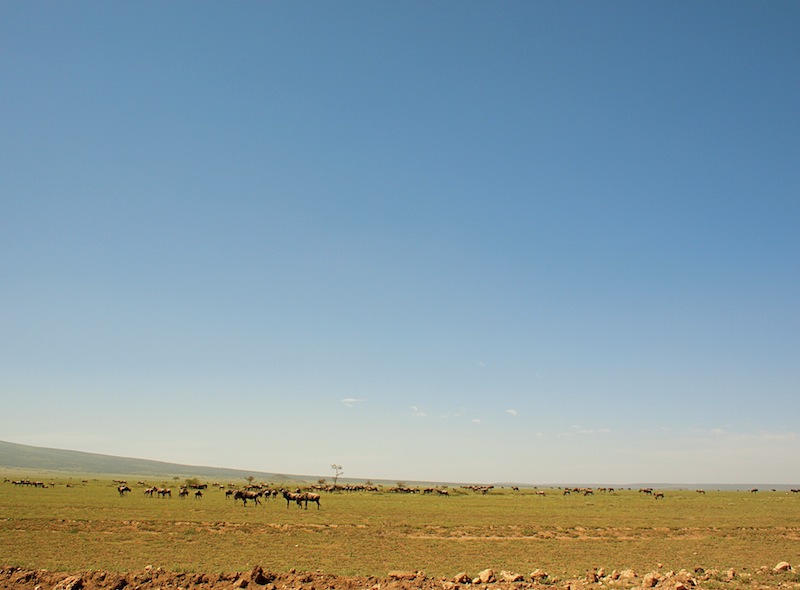
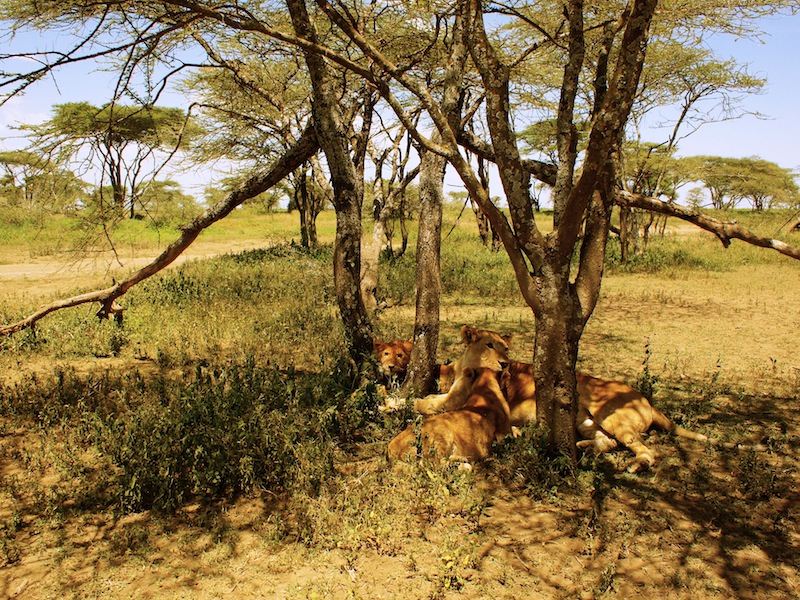
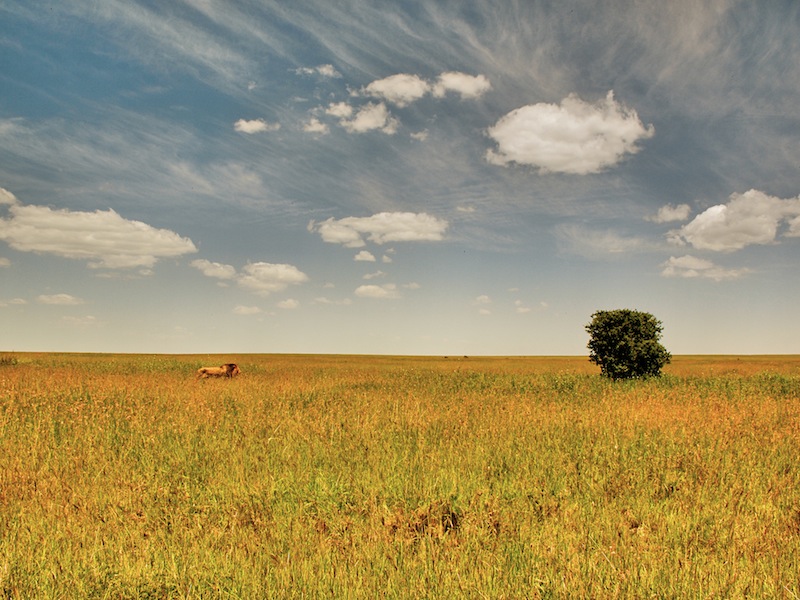
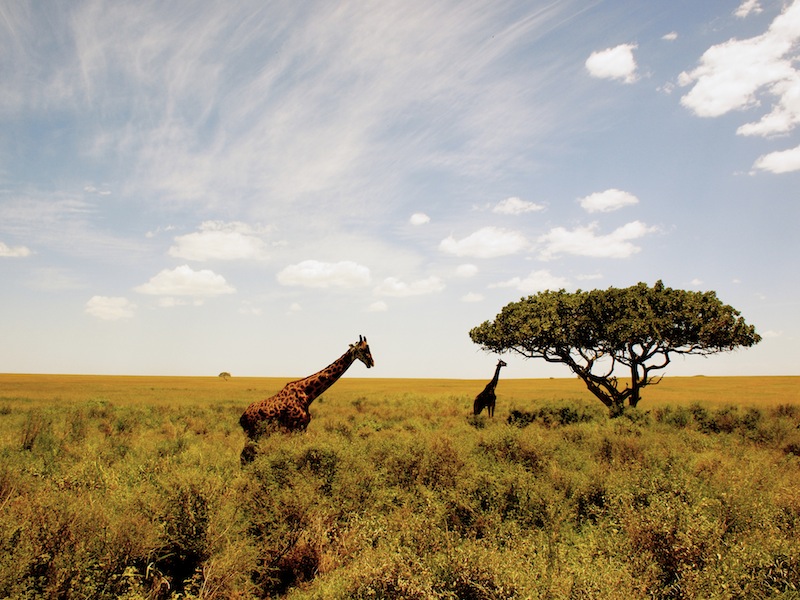
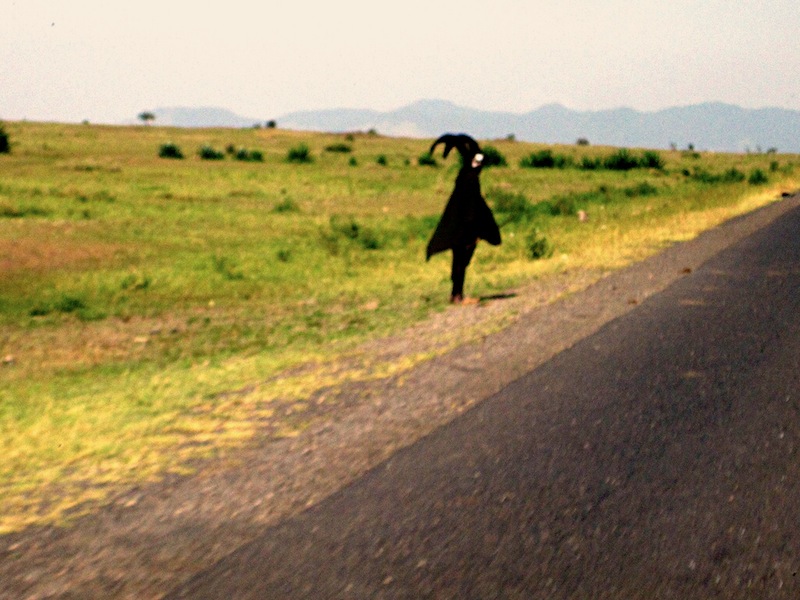



Ohhhhh what an adventure, what a journey, what a story teller! My heart was racing, thinking about what would happen in that taxi. I was saying a little paryer for you to get there (forgetting the outcome had already come and gone). I am not sure if I will ever see this part of the world, so I am so glad to have read about it through you. It all sounds so magical. Well, almost all….
Thanks for linking up this week for #SundayTraveler. I have pinned this post, I do hope that’s okay.
Thanks a lot, Sarah-Jane! I do hope you are able to see this part of our world one day – it was one of our most memorable travels, and I still get goose bumps when I think of our time in the Serengeti. Good luck and safe travels!
And now I feel like I visited Tanzania. What a great journey you gave me through your writing and the photos. Photos are gorgeous! I guess you’ll not just pick up any driver any more when in Africa :).
Ha! We still have our silly transportation moments, but Africa was an altogether different beast. All worked out in the end, and we loved everything – even the taxi drivers 🙂 Thank you so much for your kind words. Good luck!
Wow, I honestly don’t think I could ever get tired of reading your updates. A trip to Tanzania has been in my plans for a long time. Some friends of mine went a few years ago to volunteer in some small villages and said it is one of the friendliest and most spectacular countries they have ever visited. Being a huge wildlife buff, it would be a dream to visit Ngorongoro and the Serengeti. It sounds like you guys did the trip mostly “on your own” – how did you find the planning and traveling? Safe travels and best wishes!
Hola Travis! We absolutely fell in love with Tanzania – the people, the colors, the wildlife. We hope to go back one day and spend more time there. Planning and traveling was a breeze. The safari stuff all came in a package, which was a first for us, but everything else we did ourselves – including getting on buses and such. Northern Tanzania was a breeze, Dar Es Salaam not so much, but we left unscathed 🙂 Hope you visit Tanzania one day! Thank you for your kind words and good luck!
Just wow!! Sounds like you had the perfect trip, and your write up makes me want to go NOW! It’s certainly on our list of places to go, having read this it’s moved up a few places 🙂 Thanks for the lovely pics too!
Hola! We did have an extraordinary trip – waking up in the Serengeti is one of those memories I will hold close to my heart for as long as I live. Hope you make it there one day – it’s a unique place. Thank you very much for your kind words. Good luck and safe travels!
What a magnificent adventure!! Visiting the Serengeti is in my top 5 trips. You brought it to life! I think I need to move it closer to the top!! Thank you for sharing and joining #SundayTraveler.
Hola Nancie Lee! Yes, you should move the Serengeti to the top – it’s a bewildering place 🙂 Thank you so much for visiting and good luck!
I loved reading this and thought that your photos were fantastic. #SundayTraveler
Thanks a lot Jonathan! Good luck!
This is my absolute dream trip! So jealous 🙂 Your pictures of the landscape and everything you saw are just stunning! Thank you for virtually taking us there in vivid details. What an incredible trip and experience. It’ll be awhile before we get there but at least I know what to expect and feel so inspired from your post.
Thank you so much for your kind words, Mary! It really was one of our most memorable trips. Hope you make it to Tanzania one day. Good luck and safe travels!
What a beautiful post and set of photos. I have been down to Kenya but Tanzania is very high on my list of destinations here in east Africa. I love the view of Kili from the cabins – it will help me sell my wife on them!
Thanks a lot, Dave, you’re very kind. Northern Tanzania is stunning. Hope you can sell that view of Kili to your wife – it was priceless to us 🙂 Good luck and safe travels!
What a great trip! Loved all the photos, loved the narration, felt like I was with you. And ohhh my that is a lot of hippos in that little space of water…would not want to get in there! Lovely lovely post guys 🙂
Thank you so much, Samantha, you’re very kind. Good luck and safe travels!
Wow what an excellent tour and photos…that is such a strange costumed native – that would have freaked me out…I love the gorgeous and lux huts that you stayed! Please come join us and also link up for Travel Photo Mondays, the link is already live!.
Thank you so much, Noel. We’ve added it to Travel Photo Mondays. Good luck and safe travels!
Great photos 🙂
Gracias, Muza-chan! Good luck and safe travels!
What a gorgeous set of photos and a beautiful narrative to go along with it. I would love to wake up in the Serengeti but I don’t know if it will ever happen to me. Hopefully though!
Thanks a lot, Adelina! I never thought I’d wake up in the Serengeti either, like I never thought I’d be inside the Great Pyramid of Giza, like I never thought I’d see Mt Fuji, like I never thought I’d do many of the things I’ve done. My point is: if an idiot born in a small town in Southern Europe can do it, most people can too. Here’s to your trip to the Serengeti! Good luck and safe travels!
I can’t express how much I loved this post. I haven’t made it to Africa yet and probably won’t for a while…reason being that I know that once I’m there, I’m going to be there for a while. I’ve always felt connected to Africa for some reason. Loved the photos! Thanks for linking up this week 🙂
Thanks a lot, Ashley. I hope you make it to Africa one day – even if you end up staying for a long period of time 🙂 Good luck!
Your photos are absolutely stunning. The sunrise is just captivating. Touring Kenya and Tanzania are on my wish list for 2015.
Thank you Regina, glad you’ve enjoyed our photos. Hope you make it to Tanzania and Kenya in 2015! 🙂 Good luck!